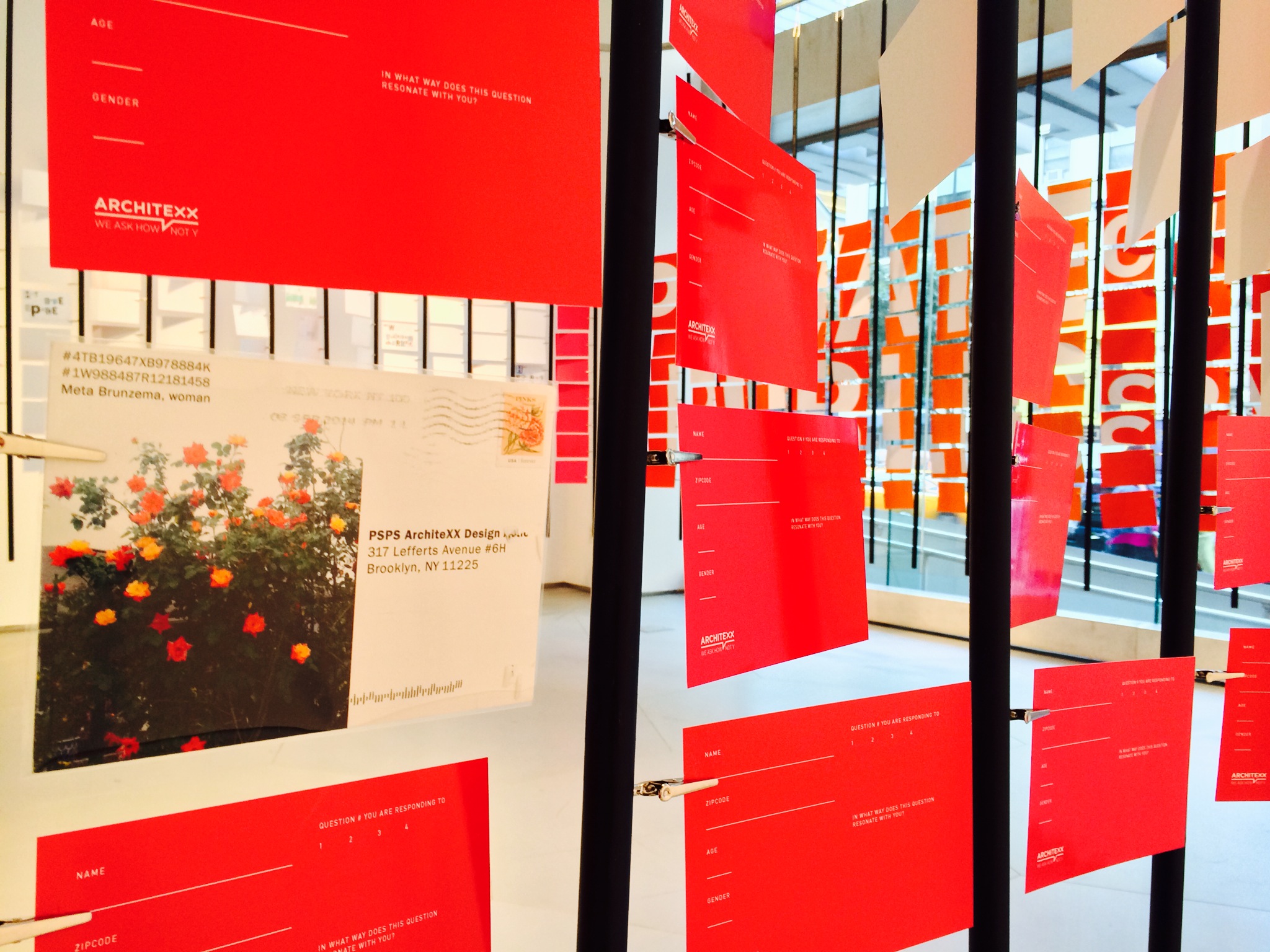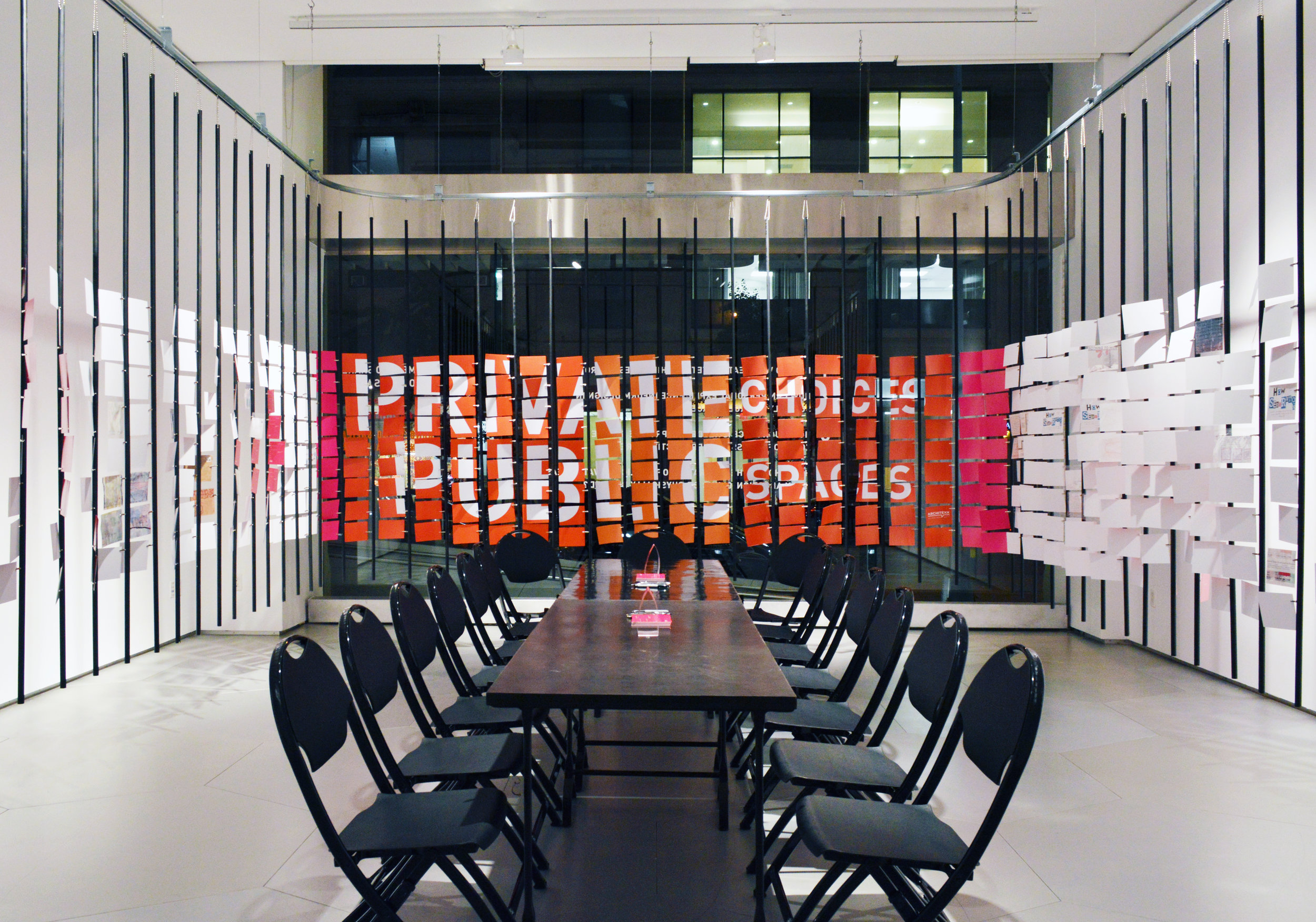Private Choices, Public Spaces Exhibition Review
Sub_teXXt Editor Shea Gilligan interviewed Architects Lori Brown and Kimberly Tate about the recent exhibit and design action, Private Choices, Public Spaces held in the Sheila C. Johnson Design Center and Sheila Aronson Galleries at Parson’s The New School for Design. The exhibit displayed the results of a call for designs to reimagine the public-private interface along the fence of the Jackson Women's Health Organization, the last remaining abortion clinic in the state of Mississippi. The ArchiteXX-lead initiative in 2014 solicited designs to provide safe and respectful access to the clinic while retaining required emergency clearances from the clinic’s front doors. Here Brown and Tate discuss their process and the next steps for the ongoing project. All photographs are copyright of Ashley Simone Photography.
Tell us more about the decision to make this call for submissions open to other disciplines? What was your intention in doing this?
LB: Part of the motivation of the project is to engage as broad and diverse audience as possible both in conversation about the role of design in our built environment and to foster more engagement and feedback about such a contentious issue. We think that by having it open to other disciplines, these goals would be better enriched and also in turn, help educate us about concerns we may not have considered.
KT: Architecture does not operate in a vacuum and 'architecture-only' can never be the complete solution, even if there is a spatial dimension to the problem under scrutiny. It was integral to our design action methodology to invite divergent and multidisciplinary voices into our design discussion and in so doing expand our understanding of the social, political and personal issues at play. We are interested in learning how other creative disciplines might approach this interface of public and private and the fence in Mississippi. We want to deepen the design discussion.
In the same way, we are interested in breaking open the social/political discussion around access to abortion by introducing voices of designers, particularly architects, and we’re starting with the the contested space of the fence at the Jackson Mississippi clinic. Lori’s research calls attention to restrictions placed on or “required” of abortion clinics, many of which constrain facilities based on their architecture. Trained architects must participate in the debate around these socially charged spaces!
How did you publicize the call-for submissions? How were requests received, overall, from within the architecture community? From outside of architecture?
LB: We sent out hundreds of emails, facebook announcements and tweets throughout our own networks as well as to media people across the globe. I think we were both underwhelmed by volume but completely overwhelmed and thoroughly inspired by content. We are going to continue to accept more submittals as the exhibit travels.
KT: We designed the call to be collaborative rather than competitive. Our crowd-sourced call invited the design community to support, or “back,” the project and our mission to provide safer access to the last remaining abortion clinic in Mississippi. We were excited to offer contributors/backers the opportunity to exhibit their work in our show in a public storefront in New York City.
This first time around most of the contributions came from within architecture, likely because our own networks and methods of outreach follow our own professional and academic channels. We hope that as the project continues and our exhibition travels we will inspire more architects and non-architects to build the design discourse.
Was there a submission that really caught your attention in this first round?
Oh yes, there are many. I think Poofs’ inflatable and responsive system is just brilliant. Their sense of humor is such a nice change to the typical high minded and serious design solutions you see coming out of big design competitions. Their submittal directly takes on the serious issues of security and visibility that all clinics, not only the Mississippi clinic, are required to address. And their proposal is temporal and changes to directly respond to sound levels and crowd sizes. Another one I really like is your proposal of wrapping the clinic in water fountains, Shea. I think the impact of this would be just incredible: the sound for one who really muffle if not completely overpower the noise from the protestors. The cooling effect in the hot months would be tremendous. I also think the plant life that could be grown in and around could also work well with the water feature. And the scale of the fountain could really mask the fence and the protestors. Another important effect would be that people may not want to stand so close to the spraying water so, this enlarges the zone of protection. Two others I really appreciate are Meta Brunzema’s wall of rose bushes. I think they would be such a beautiful plant to walk by, they smell wonderful and can grow quite large further wrapping the fence. Due to their thorns, they would also provide a larger space of protection, because one would not want to get too close or be hurt. The other submittal is by coletivo-rt. They proposed a beautiful faceted surface that would wrap around the entire fence. I think it is a beautiful element that would so nicely engage the arts district where the clinic is located.
KT: I have been astounded by each individual postcard received. The proposals are wildly imaginative, funny and well-considered. Submissions from women who design from personal experience of having an abortion are particularly provoking.
Tell us more about your decision to start this exhibit on Fifth Avenue, in Manhattan, NYC? Was that a comment about bringing visibility to a topic that frequently goes unseen and unacknowledged, especially by the architecture community at large?
LB: We are so fortunate to have had the opportunity to open The Sheila C. Johnson Design Center and Sheila Aronson Galleries at Parson’s The New School for Design’s fall 2014 exhibition season. It was so exciting to be able to have both the exhibit and all our incredible programming take place on Fifth Avenue in downtown New York. We felt it was an important way to bring the larger design and politically engaged communities in New York together to discuss the important role of design for the broader public and to bring together a diverse group of academics, designers, artists and lawyers to speak from their own particular perspectives and experiences. It was also a way to put more pressure on the architecture discipline in hopes of encouraging more engagement in such issues.
KT: The Sheila C. Johnson Design Center and Sheila Aronson Galleries at Parson’s The New School for Design was an ideal host for the first exhibition of the project. We were able to invite New School faculty and New York professionals with related activist practices or have related research on the political or social space of an abortion clinic. We are also grateful for having the interest of the curatorial staff to encourage the critical framing of the exhibition for the ongoing development of this project. Timeline and venue gave the project form. It forced us to commit to realizing the project, not just keeping it in the realm of ideas, theory and speculation. By many parts this public exhibition catalyzed our design action.
This exhibit will be traveling, correct? Where should we look for this next? Will the exhibit change over time as it adapts to different venues?
LB: Yes, the exhibit will be traveling. The next place it will travel to is Jackson, MS. We are in the process of working out all logistics with a local person who has connections with the Jackson community. We will also be having a roundtable discussion and design charette . This is the model we are going to continue as the exhibit travels to other highly contested states where abortion is highly restricted due to state legislatures and anti-choice efforts. The exhibit will grow as it moves – meaning we will encourage and accept more postcard submittals from the local communities we will be meeting and collaborating with.
KT: The exhibition itself can be considered a design action. By deploying it in other states, it will serve to raise consciousness and hopefully instigate local action. The installation was designed to incorporate 500 postcards. Hopefully as this travels we will amass enough to fill it many times over. We want more designers talking about and contributing to this socially charged debate! We want to continue breaking open the discussion through design!
The programming around the exhibit seemed integral to the design intent - which was partly to encourage participation and generate discussion, correct?
LB: Yes, it was absolutely essential and integral to the exhibit. The conversation and discussion is central to how we have conceptualized the design action in general. Without a broader public discourse, we do not believe design has enough relevancy and impact to the everyday. Like we mentioned, a multiplicity of voices is also vital to the way we are trying to work. Designers and architects cannot remain within our own bubble but be out in the world helping to change it.
KT: Yes! The public discussion is critical to the design action. Again, we want more designers talking about and contributing to these contested issues. We also want to hear more interdisciplinary viewpoints to inform the architectural design.
How will the final selection happen? Which submission will ultimately get built?
LB: We are still in the process of figuring this out. Thus far, we are inspired by aspects from many of the submittals. We hope to engage with those designers and directly bring in and evolve some of their ideas into what will become the proposal. This will of course also be done in collaboration with the Jackson Women’s Health Organization.
KT: We are inspired by the promise of so many submissions! We are starting to envision the built action as multi-phased, or multi-manifested. What gets built will hugely depend on the funding, which we are working on raising now. We would love for the final, permanent installation in Mississippi to integrate a combination of the ideas submitted. As the exhibition travels, we hope to garner further financial support to get the ideas built. Of course, not all the concepts will be built, but we hope to inspire others to take action locally.
Is this intended to act like a case study for ideas to other clinics around the country, regarding how to provide access?
LB: We definitely hope so. We see one of the potentials of this design action is be adaptable and replicated as needed across the country. Clearly different sites with have different constraints and specific issues to address. However, the larger issues of security, privacy and aesthetic quality are a priority for all clinics.
KT: Perhaps for other clinics and communities the catalogue of postcards submitted can serve as a resource of ideas to deploy directly or be inspired by. We are also entertaining the idea of the installation being somehow adaptable to other physical spaces.
Are there any precedents, that you are aware of, of this kind of activism happening within architecture?
LB: We wish there were, but as of now are still looking for them and hope to find some.
Private Choices Public Spaces
Curators: Lori Brown, Kimberly Tate
Exhibition Designers: Ashley Simone, Michele Gorman, Irina Schneid, Lisa Maione
Graphics and Communications: Jen Grosso, Shea Sabino, Sarah Rafson
Volunteers: John Bryant, João Carneiro, Alejandra Chinea, Rebekah Dempsey, Alison Dobbertin, Anne Englot, Cat Fan, René Fan, Allison Frank-Schlegel, Nina Freedman, Thomas Gallione, Mariana Hinojosa, Alina Hoffman, Tyler Holdren, Maggie Huang, Kristina Kaufman, Dana Koenitzer, Cesi Kohen, Karen Kubey, Daniel Mabie, Andrea Merrett, Seok Min Yeo, Fanyi Pan, Emily Rebecca, Josefina Rosario, Radhika Subramaniam, Winnie Tu, Vinh Vo, Dabota Wilcox, June Williamson, Daisy Wong, Lily Wong, Cansu Yanik, Matthew Zay
Supported, in part, by Abortion Conversation Project; Syracuse University School of Architecture; Megan Offner, NY Heartwoods; and Thomas Gallione, Ryan Associates
Ashley Simone is a New York City based artist and architect. She takes a multidisciplinary approach to the fields, operating as a designer, photographer, writer and educator. She holds a Masters in Architecture from the Graduate School of Architecture, Planning and Preservation at Columbia University and a Bachelor of Arts in Economics from The College of William and Mary.
Shea Gilligan is a New York City based architect, activist, writer and editor. In addition to being a full time practicing architect, she founder and co-editor of sub_teXXt, the online journal of architeXX, which aims to transform the profession of architecture through challenging the status quo, questioning unsustainable practices and promoting through publication the up-and-coming, as-yet-unheard-of designers.




